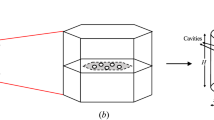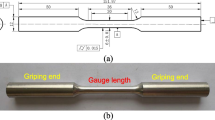Abstract
We develop a method aimed at the evaluation of the residual strength of cracked structural elements strengthened with the help of injection technologies. The basic parameters responsible for the efficiency of injection are established and possible ways of optimization of the proposed technology are indicated.
Similar content being viewed by others
References
A. A. Griffith, “The phenomenon of rupture and flow in solids,” Phil. Trans. Roy. Soc. Ser. A, No. 221, 163–198 (1920).
G. R. Irwin, “Analysis of stresses and strain near the end of a crack traversing a plate,” J. Appl. Mech., No. 3, 24 (1957).
V. V. Panasyuk, M. M. Stadnik, and V. P. Silovanyuk, Stress Concentration in Three-Dimensional Bodies with Thin Inclusions [in Russian], Naukova Dumka, Kiev (1986).
N. I. Muskhelishvili, Some Basic Problems of the Mathematical Elasticity Theory [in Russian], Nauka, Moscow (1966).
S. Ya. Yarema and G. S. Krestin, “Determination of the modulus of adhesion for brittle materials by testing cracked disks for compression,” Fiz.-Khim. Mekh. Mater., 2, No. 1, 10–14 (1966).
Author information
Authors and Affiliations
Additional information
__________
Translated from Fizyko-Khimichna Mekhanika Materialiv, Vol. 41, No. 6, pp. 60–64, November–December, 2005.
Rights and permissions
About this article
Cite this article
Panasyuk, V.V., Sylovanyuk, V.P. & Marukha, V.I. Strength of cracked structural elements healed by injection methods. Mater Sci 41, 777–783 (2005). https://doi.org/10.1007/s11003-006-0044-2
Received:
Issue Date:
DOI: https://doi.org/10.1007/s11003-006-0044-2




